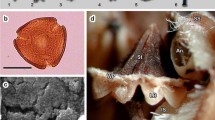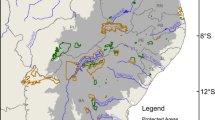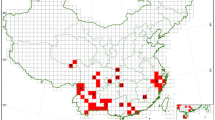Abstract
The purpose of this paper was to analyze the diversity patterns of Cactaceae at a global scale, to identify those countries where conservation actions should be performed. In order to do this, the species richness and the number of endemic species for 34 American countries were determined. With these data, the relationship between the total number of species or the number of endemic species and the area of the countries were analyzed. In addition, a complementarity analysis was conducted to determine the most important countries for cactus conservation. Results showed that Mexico had the highest number of total and endemic species followed by Argentina, Bolivia, Brazil, and Peru, among others. There was a significant positive relationship between both, the total and endemic species, and the area of the countries. Despite this fact, the cactus diversity in Mexico, Argentina, Peru, Bolivia, Chile, and Costa Rica was higher than expected according to their area. Further, these countries also presented the highest proportions of endemic species. The complementarity analysis indicated that 24 countries are necessary to preserve all cactus species. However, 94% of all species could be preserved with only 10 countries. Considering the diversity patterns and the complementarity analysis, three important groups for cactus conservation were identified: (1) Mexico, Argentina, Peru, Bolivia, Chile, and Costa Rica, (2) Paraguay and Cuba, and (3) Brazil and USA. Conservation efforts should be focused on these countries in order to preserve cactus diversity.
Similar content being viewed by others
References
H. Arita (1997) ArticleTitleThe non-volant mammal fauna of México: species richness in a megadiverse country Biodiver. Conserv. 6 787–795 Occurrence Handle10.1023/B:BIOC.0000010402.08813.ab
T.H. Boyle E. Anderson (2002) Biodiversity and Conservation P.S. Nobel (Eds) Cacti. Biology and Uses University of California Press Los Angeles 125–141
H. Bravo-Hollis H. Sánchez Mejorada (1978) Las Cactáceas de México NumberInSeriesVol. I Universidad Nacional Autónoma de México México D.F
Brown J.H. and Lomolino M.V. 1998. Biogeography. Sinauer Associates, Inc. Publishers.
J.O. Caldecott M.D. Jenkins T.H. Johnson B. Groombridge (1996) ArticleTitlePriorities for conserving global species richness and endemism Biodiver. Conserv. 5 699–727 Occurrence Handle10.1007/BF00051782
G. Ceballos J.H. Brown (1995) ArticleTitleGlobal patterns of mammalian diversity, endemismand endangerment Conserv. Biol. 9 559–568
G. Ceballos P. Rodríguez R. Medellín (1998) ArticleTitleAssesing conservation priorities in megadiverse Mexico: mammalian diversity, endemicity, and endangerment Ecol. Appl. 8 8–17
T.H. Fleming A. Valiente-Banuet (Eds) (2002) Columnar cacti and their mutualists. Evolution, ecology and conservation The University of Arizona Press Tucson
A.C. Gibson P.S. Nobel (1986) The cactus primer Harvard University Press Cambridge, Massachusetts
H. Godínez-Alvarez T. Valverde P. Ortega-Baes (2003) ArticleTitleDemographic trends in the cactaceae Bot. Rev. 69 173–203
C. Gómez-Hinostrosa H.M. Hernández (2000) ArticleTitleDiversity, geographical distribution and conservation of Cactaceae in the Mier y Noriega region, Mexico Biodiver. Conserv. 9 403–418 Occurrence Handle10.1023/A:1008935710910
H.M. Hernández H. Godínez (1994) ArticleTitleContribución al conocimiento de las cactáceas mexicanas amenazadas Acta Botánica Mexicana 26 33–52
H.M. Hernández R.T. Bárcenas (1995) ArticleTitleEndangered cacti in the Chihuahuan Desert. I. Distribution patterns Conserv. Biol. 9 1176–1188 Occurrence Handle10.1046/j.1523-1739.1995.09051176.x
H.M. Hernández R.T. Bárcenas (1996) ArticleTitleEndangered cacti in the Chihuahuan Desert. II. Biogeography and conservation Conserv. Biol. 10 1200–1209
H.M. Hernández C. Gómez-Hinostrosa R.T. Bárcenas (2001) ArticleTitleDiversity, spatial arrangementand endemism of Cactaceae in the Huizache areaa hot-spot in the Chihuahuan Desert Biodiver. Conserv. 10 1097–1112 Occurrence Handle10.1023/A:1016606216041
H.M. Hernández C. Gómez-Hinostrosa (2002) An integrated approach to the conservation of cacti in Mexico M. Maunder C. Clubbe C. Hankamer M. Groves (Eds) Plant Conservation in the Neotropics Royal Botanical Gardens Kew Great Britain 350–367
D. Hunt (1999) CITES. Cactaceae checklist Royal Botanic Gardens Kew and International Organization for Succulent Plant Study U. K
M.A. Mares (1992) ArticleTitleNeotropical mammals and the myth of Amazonian biodiversity Science 255 976–979
R.A. Mittermeier (1988) Primate diversity and the tropical forest: case studies from Brazil and Madagascar and the importance of the megadiversitu countries E.O. Wilson (Eds) Biodiversity National Academic Press Washington 145–153
R.A. Mittermeier P.R. Gil C.G. Mittermeier (1997) Megadiversidad. Los países biológicamente más ricos del mundo CEMEX México
R.A. Mittermeier N. Myers J.B. Thomsen (1998) ArticleTitleBiodiversity hotspot and major tropical wilderness areas: approaches to setting conservation priorities Conserv. Biol. 12 516–520 Occurrence Handle10.1046/j.1523-1739.1998.012003516.x
N. Myers (1988) ArticleTitleThreatened biotas: hotspots in tropical forests Environmentalist 8 178–208
N. Myers (1990) ArticleTitleThe biodiversity challenge: expanded hot-spots analysis Environmentalist 10 243–256 Occurrence Handle10.1007/BF02239720 Occurrence Handle1:STN:280:DC%2BD38ngsFCrtg%3D%3D Occurrence Handle12322583
P.S. Nobel (Eds) (2002) Cacti. Biology and uses University of California Press Los Angeles, USA
S. Oldfield (1997) Cactus and succulent plants: status survey and conservation action plan. IUCN/SSC cactus and succulent specialist group International Union for Conservation of Nature and Natural Resources Gland, Switzerland, and Cambridge, United Kingdom
Oxford. 1996. Atlas of the world. Oxford University Press.
R. Primack R. Rozzi P. Feinsinger R. Dirzo F. Massardo (2001) Fundamentos de la conservación biológica: Perspectivas Latinoamericanas Fondo de Cultura Económica México
K.H. Redford A. Taber J.A. Simonetti (1990) ArticleTitleThere is more to biodiversity than the tropical rain forests Conserv. Biol. 4 328–330 Occurrence Handle10.1111/j.1523-1739.1990.tb00296.x
Rzedowski J. 1992. El endemismo en la flora fanerogámica mexicana: una apreciación analítica preliminar. In: Halffter G. (ed.), La diversidad biológica de Iberoamérica Acta Zoológica Mexicana. vol. especial, pp. 337–359.
T.D. Sisk A.E. Launer K.R. Switky P.R. Ehrlich (1994) ArticleTitleIdentifying extinction threats Bioscience 44 592–604
Author information
Authors and Affiliations
Corresponding author
Rights and permissions
About this article
Cite this article
Ortega-Baes, P., Godínez-Alvarez, H. Global Diversity and Conservation Priorities in the Cactaceae. Biodivers Conserv 15, 817–827 (2006). https://doi.org/10.1007/s10531-004-1461-x
Received:
Accepted:
Published:
Issue Date:
DOI: https://doi.org/10.1007/s10531-004-1461-x




